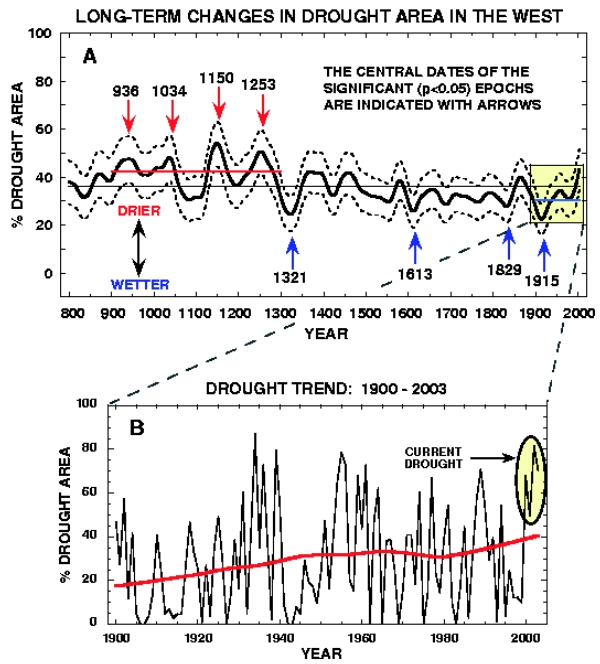Comparing the 2012 drought to the Dust Bowl droughts of the 1930s
The great U.S. drought of 2012 remained about the same size and intensity over the past week, said NOAA in their weekly U.S. Drought Monitor report issued Thursday, August 16. The area of the contiguous U.S. covered by drought remained constant at 62%, and the area covered by severe or greater drought also remained constant at 46%. However, the area covered by the highest level of drought--exceptional--increased by 50%, from 4% to 6%. Large expansions of exceptional drought occurred over the heart of America's grain producing areas, in Kansas, Nebraska, Oklahoma, and Missouri. The new NOAA State of the Climate Drought report for July 2012 shows that the 2012 drought is 5th greatest in U.S. history, and the worst in 56 years. The top five years for area of the contiguous U.S. covered by moderate or greater drought:
1) Jul 1934, 80%
2) Dec 1939, 60%
3) Jul 1954, 60%
4) Dec 1956, 58%
5) Jul 2012, 57%
The top five years for the area of the contiguous U.S. covered by severe or greater drought:
1) Jul 1934, 63%
2) Sep 1954, 50%
3) Dec 1956, 46%
4) Aug 1936, 43%
5) Jul 2012, 38%
Figure 1. August 14, 2012 drought conditions showed historic levels of drought across the U.S., with 62% of the contiguous U.S. experiencing moderate or greater drought, and 46% of the county experiencing severe or greater drought. Image credit: U.S. Drought Monitor....MORE
And from "The characteristics and likely causes of the Medieval megadroughts in North America":
Figure 1

| Top, the percent of the area of the American West experiencing moderate to severe drought at any one time as reconstructed from tree ring records over the last millennium. The time series has been filtered to emphasize variations on timescales of many decades to centuries. The lower panel shows a blowup for the last century emphasizing that the recent drought was not historically exceptional. The figure is taken from Cook et al. (2004, Science). During Medieval times serious drought affected large areas of the West. Following that there was a long period of more moderate drought (corresponding to the Little Ice Age) and, since then there appears to have been a return to a more drought stricken climate. |

...MORE
Last but not least (14 page PDF): Megadroughts in North America: placing IPCC projections of hydroclimatic change in a long-term palaeoclimate context
...There is an excellent understanding now that the multi-year historical droughts in the West are frequently linked to cool La Nin˜ a-like sea surface temperatures (SSTs) in the tropical Pacific El Nin˜o–Southern Oscillation (ENSO) region (e.g. Cole et al., 2002; Fye et al., 2004; Seager et al., 2005; Herweijer et al., 2006; Cook et al., 2007; Herweijer and Seager, 2008), the turn of the century drought being the most recent example (Seager, 2007).
There is also a strong indication that inter-annual drought and wetness in the Mississippi Valley are associated with the state of the North Atlantic Oscillation (NAO) (Fye et al., 2006). Recent modelling studies by Seager et al. (2008a) and Feng et al. (2008) have also tested the influence of both Atlantic and Pacific SSTs on the development of drought in North America. Their results suggest that either a cold tropical Pacific or a warm North Atlantic can produce droughts. Feng et al. (2008) argued that both are probably necessary to produce the intensity and longevity of megadroughts in North America.
Despite improved understanding of the causes of droughts on the multi-year to decadal timescale, the causes during the Medieval period of multi-decadal droughts grouped together in a period that lasted centuries remain largely unknown. On longer than multi-year timescales, McCabe et al. (2004) and Huang et al. (2005) have argued that Pacific decadal variability (sometimes called the Pacific Decadal Oscillation
(PDO); Mantua et al., 1997) and the Atlantic Multi-decadal Oscillation (AMO; Enfield et al., 2001) are important contributors to the low-frequency modulation of wetness and dryness over North America.
Since the PDO (20–30 years) and theAMO(65–80 years) have timescales of variability consistent with the duration of past megadroughts, it is conceivable that they have contributed to the development of those epochs. However, the PDO could also be just a low-frequency version of ENSO (Zhang et al., 1997), so it need not necessarily be an independent contributor to low-frequency drought variability over North America. The AMO may be a different matter based on the modelling results of Sutton and Hodson (2005, 2007), Feng et al. (2008) and Seager et al. (2008a), which all showed that warm tropical North Atlantic SSTs can induce drying over western and southern North America. In addition, Dong et al. (2006) suggest that the AMO may even modulate ENSO on multi-decadal timescales via the impact it has on winds over the tropical Pacific Ocean. It remains unclear, however, whether these natural phenomena could give rise to the centennial timescale variations seen in the North American drought record or whether external forcing must be appealed to....